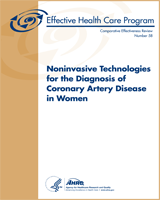NCBI Bookshelf. A service of the National Library of Medicine, National Institutes of Health.
This publication is provided for historical reference only and the information may be out of date.
Structured Abstract
Objectives:
To conduct a systematic review of the medical literature assessing (1) accuracy of noninvasive technologies (NITs) for diagnosing coronary artery disease (CAD) in women with symptoms suspicious for CAD, (2) predictors affecting test accuracy, (3) ability of NITs to provide risk stratification, prognostic information, inform decisionmaking about treatment options, and affect clinical outcomes, and (4) risks to women undergoing these tests.
Data Sources:
MEDLINE®, PubMed®, Embase®, and Cochrane Database of Systematic Reviews.
Review Methods:
Studies published in English through September 2011 with sex-specific outcomes comparing exercise/stress electrocardiography (ECG), echocardiography (ECHO), single proton emission computed tomography (SPECT), cardiac magnetic resonance (CMR), or coronary computed tomography angiography (coronary CTA) with another NIT, or with coronary angiography. We ran separate meta-analyses of the accuracy of each NIT modality compared with coronary angiography on the no known and mixed CAD populations in women and in men.
Results:
A total of 104 comparative studies (110 articles) were included. For women with no known CAD, the summary of accuracy for each NIT modality compared with coronary angiography was ECG (29 studies), sensitivity 62 percent, specificity 68 percent; ECHO (14 studies), sensitivity 79 percent, specificity 83 percent; SPECT (14 studies), sensitivity 81 percent, specificity 78 percent; CMR (5 studies), sensitivity 72 percent, specificity 84 percent; and CTA (5 studies), sensitivity 94 percent, specificity 87 percent. Compared with men, in women ECG and coronary CTA modalities were both less sensitive and less specific. The ECHO and SPECT modalities, although less sensitive, appeared to be more specific in women. The lower specificity of the ECG modality in women was the only statistically significant difference. Strength of evidence was high for ECG, ECHO, and SPECT and low for CMR and coronary CTA compared with coronary angiography in women. Eleven comparative studies examined predictors of diagnostic accuracy in women such as postmenopausal status, race/ethnicity, heart size, beta blocker use, and pretest probability; insufficient evidence was available to draw conclusions about predictors that affect accuracy. Eight studies assessed risk stratification and prognostic factors, two studies assessed treatment decisionmaking, and four studies provided comparative clinical outcomes. There is insufficient evidence on the comparative effectiveness of NITs to provide risk stratification, prognostic information, treatment decisionmaking, or impact clinical outcomes in women. Thirteen comparative studies reported risks. Of these, four studies of coronary CTA showed a higher mean effective radiation dose and attributable risk of cancer incidence in women compared with men; however, radiation safety issues were not discussed in other NIT modalities with radiation exposure. Thus, there was insufficient evidence regarding the comparative risks of various NIT modalities in women.
Conclusions:
This systematic review provides evidence for the summary sensitivities and specificities of exercise/stress ECG, ECHO, SPECT, CMR, and coronary CTA compared with coronary angiography used for diagnosing CAD in women. There was limited or insufficient evidence from comparative studies to define the influence of clinical and demographic factors on NIT diagnostic accuracy, risk stratification, prognostic information, treatment decisions, clinical outcomes, and harms in women.
Contents
Prepared for: Agency for Healthcare Research and Quality, U.S. Department of Health and Human Services1, Contract No. 290-2007-10066-I, Prepared by: Duke Evidence-based Practice Center, Durham, NC
Suggested citation:
Dolor RJ, Patel MR, Melloni C, Chatterjee R, McBroom AJ, Musty MD, Wing L, Coeytaux RR, Ross AK, Bastian LA, Anderson M, Kosinski AS, Sanders GD. Noninvasive Technologies for the Diagnosis of Coronary Artery Disease in Women. Comparative Effectiveness Review No. 58. (Prepared by the Duke Evidence-based Practice Center under Contract No. 290-2007-10066-I.) AHRQ Publication No. 12-EHC034-EF. Rockville, MD: Agency for Healthcare Research and Quality. June 2012. www.effectivehealthcare.ahrq.gov/reports/final.cfm.
This report is based on research conducted by the Duke Evidence-based Practice Center (EPC) under contract to the Agency for Healthcare Research and Quality (AHRQ), Rockville, MD (Contract No. 290-2007-10066-I). The findings and conclusions in this document are those of the authors, who are responsible for its contents; the findings and conclusions do not necessarily represent the views of AHRQ. Therefore, no statement in this report should be construed as an official position of AHRQ or of the U.S. Department of Health and Human Services.
The information in this report is intended to help health care decisionmakers—patients and clinicians, health system leaders, and policymakers, among others—make well-informed decisions and thereby improve the quality of health care services. This report is not intended to be a substitute for the application of clinical judgment. Anyone who makes decisions concerning the provision of clinical care should consider this report in the same way as any medical reference and in conjunction with all other pertinent information, i.e., in the context of available resources and circumstances presented by individual patients.
This report may be used, in whole or in part, as the basis for development of clinical practice guidelines and other quality enhancement tools, or as a basis for reimbursement and coverage policies. AHRQ or U.S. Department of Health and Human Services endorsement of such derivative products may not be stated or implied.
None of the investigators has any affiliations or financial involvement that conflicts with the material presented in this report.
- 1
540 Gaither Road, Rockville, MD 20850; www
.ahrq.gov
- Noninvasive Technologies for the Diagnosis of Coronary Artery Disease in WomenNoninvasive Technologies for the Diagnosis of Coronary Artery Disease in Women
Your browsing activity is empty.
Activity recording is turned off.
See more...
